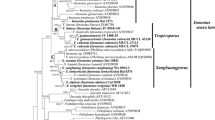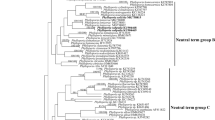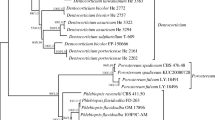Abstract
The Inonotus linteus complex comprises several closely related species characterized by pileate basidiomes, a heterogeneous hyphal system with a monomitic context and a dimitic hymenophoral trama. Setae are hymenial and basidiospores are broadly ellipsoid to subglobose, yellowish and thick-walled. Research to understand this complex have been particularly noticeable in East Asia. In the present paper, the complex was studied at a larger scale, including samples from Mesoamerica. Inonotus linteus, an epitype of this species being designated here, is circumscribed as a narrow sense based on morphological and phylogenetic data, and this has lead to delimiting a new species from Mesoamerica, viz. I. cubensis, and provides evidence for two additional species, I. alpinus and I. zonatus, from East Asia. Phylogenetic analyses of ITS sequences also confirmed the status of I. baumii, I. linteus, I. lonicericola, I. lonicerinus, I. vaninii, I. sanghuang, I. weigelae and I. weirianus as distinct taxa, while I. tenuicontextus is considered to be a synonym of I. weigelae. A key to 11 species in the complex is provided.







Similar content being viewed by others
References
Amalfi M, Raymundo T, Valenzuela R, Decock C (2012) Fomitiporia cupressicola sp. nov., a parasite on Cupressus arizonica, and additional unnamed clades in the southern USA and northern Mexico, determined by multilocus phylogenetic analyses. Mycologia 104:880–893
Berkeley MJ, Curtis MA (1860) Characters of new fungi, collected in the North Pacific exploring expedition by Charles Wright. Proc Am Acad Arts Sci 4:111–130
Bresadola G (1926) Selecta mycological 2. Stud Trent 7:51–58
Bunyard BA, Nicholson MS, Royse DJ (1994) A systematic assessment of Morchella using RFLP analysis of the 28S ribosomal RNA gene. Mycologia 86:762–772
Dai YC (2010) Hymenochaetaceae (Basidiomycota) in China. Fungal Divers 45:131–343
Dai YC, Xu MQ (1998) Studies on the medicinal polypore, Phellinus baumii, and its kin, P. linteus. Mycotaxon 67:191–200
Gilbertson RL, Ryvarden L (1987) North American polypores 2. Megasporoporia-Wrightoporia. Fungiflora, Oslo
Guindon S, Gascuel O (2003) A simple, fast and accurate method to estimate large phylogenies by maximum-likelihood. Syst Biol 52:696–704
Hall TA (1999) Bioedit: a user-friendly biological sequence alignment editor and analysis program for Windows 95/98/NT. Nucleic Acids Symp Ser (Oxf) 41:95–98
He SH, Li HJ (2011) Hymenochaete rhododendricola and H. quercicola spp. nov. (Basidiomycota, Hymenochaetales) from Tibet, southwestern China. Nord J Bot 29:484–487
Ikekawa T, Nakanishi M, Uehara N, Chihara G (1968) Anti-tumor action of some Basidiomycetes, especially Phellinus linteus. Gann 59:155–157
Jeon H, Hwang SG, Jung YH, Yang HS, Sung NY, Lee JL, Park DK, Yoo YC (2011) Inhibitory effect of oral administration of sangwhang mushroom (Phellinus linteus) grown on germinated brown rice on experimental lung metastasis and tumor growth in mice. Food Sci Biotechnol 20:209–214
Kim GY, Park SK, Lee MK, Lee SH, Oh YH, Kwak JY, Yoon S, Lee JD, Park YM (2003) Proteoglycan isolated from Phellinus linteus activates murine B lymphocytes via protein kinase C and protein tyrosine kinase. Int Immunopharmacol 3:1281–1292
Kim SH, Lee H, Lee S, Cho J, Ze K, Sung J, Kim YC (2004) Mycelial culture of Phellinus linteus protects primary cultured rat hepatocytes against hepatotoxins. J Ethnopharmacol 95:367–372
Larkin MA, Blackshields G, Brown NP, Chenna R, McGettigan PA, McWilliam H, Valentin F, Wallace IM, Wilm A, Lopez R, Thompson JD, Gibson TJ, Higgins DG (2007) Clustal W and Clustal X version 2.0. Bioinformatics 23:2947–2948
Larsson KH, Parmasto E, Fisher M, Langer E, Nakasone KK (2006) Hymenochaetales: a molecular phylogeny for the hymenochaetoid clade. Mycologia 98:926–936
Lim YW, Lee JS, Jung HS (2003) Type studies on Phellinus baumii and Phellinus linteus. Mycotaxon 85:201–210
Lyubarsky LV (1962) Polypori nonnulli rari ex riente extremo. Bot Mater Otd Spor Rast 15:111–125
Murrill WA (1903) The Polyporaceae of North America 2. The genus Pyropolyporus. Bull Torrey Club 30:109–120
Oberwinkler F (2012) Evolutionary trends in Basidiomycota. Stapfia 96:45–104
Park IH, Chung SK, Lee KB, Yoo YC, Kim SK, Kim GS, Song KS (2004) An antioxidant hispidin from the mycelial culture of Phellinus linteus. Arch Pharm Res 27:615–618
Parmasto E, Parmasto I (2001) Phellinus baumii and related species of the Ph. linteus group (Hymenochaetaceae, Hymenomycetes). Folia Cryptog Estonica 38:53–61
Patouillard PN (1907) Quelques champignons de l’Afrique occidentale. Bull Soc Mycol Fr 23:80–85
Petersen JH (1996) Farvekort. The Danish Mycological Society’s color-chart. Foreningen til Svampekundskabens Fremme, Greve
Posada D (2008) jModelTest: phylogenetic model averaging. Mol Bio Evol 25:1253–1256
Ronquist F, Huelsenbeck JP (2003) MrBayes 3: bayesian phylogenetic inference under mixed models. Bioinformatics 19:1572–1574
Teng SC (1964) Fungi of China. Science Press, Beijing
Wagner T, Fischer M (2002) Proceedings towards a natural classification of the worldwide taxa Phellinus s.l. and Inonotus s.l., and phylogenetic relationships allied genera. Mycologia 94:998–1016
White TJ, Bruns TD, Lee S, Taylor J (1990) Amplification and direct sequencing of fungal ribosomal RNA genes for phylogenetics. In: Innis MA, Gelfand DH, Sninsky JJ, White TJ (eds) PCR protocols, a guide to methods and applications. Academic, San Diego
Wu SH, Dai YC, Hattori T, Yu TW, Wang DM, Parmasto E, Chang HY, Shih SY (2012) Species clarification for the medicinally valuable ‘sanghuang’ mushroom. Bot Stud 53:135–149
Zhao CL, Cui BK (2012) A new species of Perenniporia (Polyporales, Basidiomycota) described from southern China based on morphological and molecular characters. Mycol Prog 11:555–560
Zhou LW, Dai YC (2012) Phylogeny and taxonomy of Phylloporia (Hymenochaetales) with the description of five new species and a key to worldwide species. Mycologia 104:211–222
Zhou LW, Jia BS (2010) A new species of Phellinus (Hymenochaetaceae) growing on bamboo in tropical China. Mycotaxon 114:211–216
Zhou LW, Qin WM (2012) Inonotus tenuicontextus sp. nov. (Hymenochaetaceae) from Guizhou, southwest China with a preliminary discussion on the phylogeny of its kin. Mycol Prog 11:791–798
Zhou LW, Xue HJ (2012) Fomitiporia pentaphylacis and F. tenuitubus spp. nov. (Hymenochaetales, Basidiomycota) from Guangxi, southern China. Mycol Prog. doi:10.1007/s11557-012-0806-1
Acknowledgments
The research was financed by the National Natural Science Foundation of China (Project Nos. 31070022, 30910103907, 31200015), Chinese Academy of Sciences Grant (Project No. KSCX2-EW-Z-9), and Shandong Provincial Natural Science Foundation of China (Project No. ZR2012CL03). Cony Decock gratefully acknowledges the financial support received from the Belgian State—Belgian Federal Science Policy through the BCCMTM research program and from the FNRS/FRFC (convention FRFC 2.4544.10). Specimens from Cuba were collected within the frame of CUD/PIC “Centro de Recursos geneticos Fungicos en Cuba”, and we are thankful to our Cuban colleagues, of which particularly Dr. Sara Herrera Figueroa, for their help during fieldworks.
Author information
Authors and Affiliations
Corresponding author
Rights and permissions
About this article
Cite this article
Tian, XM., Yu, HY., Zhou, LW. et al. Phylogeny and taxonomy of the Inonotus linteus complex. Fungal Diversity 58, 159–169 (2013). https://doi.org/10.1007/s13225-012-0202-9
Received:
Accepted:
Published:
Issue Date:
DOI: https://doi.org/10.1007/s13225-012-0202-9




